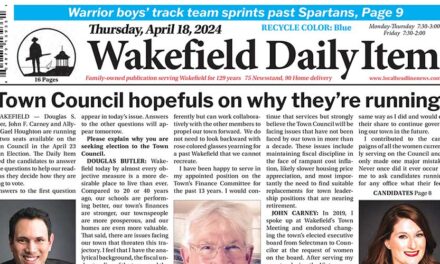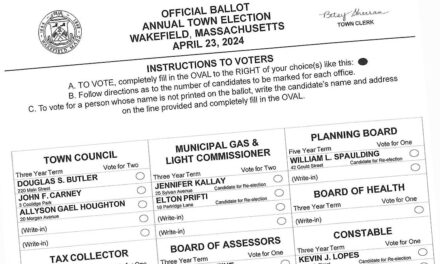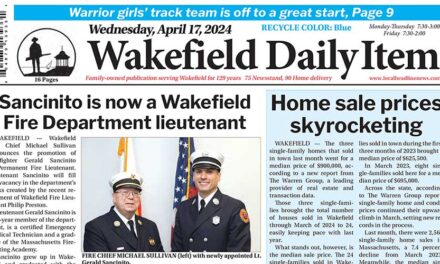Published in the June 1, 2017 edition.
By MARK SARDELLA
“Wakefield has such a pretty downtown,” my friend in the passenger seat said as we drove past The Rockery on the right, with its rows of bright red and white tulips leading up to the Hiker Statue. It was a few weeks ago and the fountain hadn’t been turned on yet.
“That’s not what our local Facebook philosophers say,” I remarked. “They call downtown Wakefield center ‘a ghost town.’”
We continued down Main Street, dodging tumbleweeds and looking for a parking space. We didn’t find one.
“Wakefield: a ghost town with a parking problem,” I thought to myself, combining two of the favorite cudgels used by locals fond of bashing the downtown, oblivious to the irony.
“I can’t believe anyone would bash Wakefield’s downtown,” my friend said. “It seems like such a good place.”
My friend lives in an affluent seaside town on the North Shore. She worked in downtown Wakefield years ago and still visits periodically.
“You have a wide variety of shops and restaurants that offer quality goods and services that are actually needed by town residents, all at a reasonable cost,” she observed. “Other towns — like my own — have few businesses that actually cater to the residents. Many seem to be focused on tourists. And those shops that do cater to residents, cater to the wealthy residents. Sure, I can find a skirt to buy in my community — if I want to pay $300. I can only afford to shop in my town when they have a sale. Same with restaurants. Most are very pricey.”
I told her that some people complain about the “tired look” of the downtown – that it seems like a hodgepodge of mismatched buildings with no uniformity in the facades or signage.
She shook her head.
“Wakefield’s town center may not seem all current and modern and that’s one reason I like it,” she said. “It is what it is. It isn’t striving to be all momentarily relevant and hip. It evokes the charm of a real town, with real people, with many buildings that have been around for generations.”
I understood what she was saying. Wakefield has an authentic downtown — a real, working class downtown that has evolved over decades, even centuries. It has acquired a few scars and warts along the way, but that’s part of its appeal. It’s not a cookie cutter downtown with a perfect, uniform look designed by an urban planner in some remote office.
I pointed out that Wakefield still has local, family-owned businesses like alano, Brothers Restaurant, Farmland and Hart’s Hardware.
That, she said, promotes the idea of shopping locally.
“People don’t have to drive 30 minutes and use up their time and gas to find a good, reasonably-priced restaurant or shop,” she said. “People can support their local businesses and keep funneling money back into their town’s coffers, instead of trekking off to another town or a mall. Better for the environment, better for the town’s economy. By contrast, in my community, residents go outside town to shop and eat, where there is a greater variety and more reasonable prices.”
As she was talking, I thought back to the “ghost town” image that many locals seem oddly attached to. They talk about the downtown as a wasteland of empty storefronts. (In fact, there are three or four vacancies. One of those is undergoing renovations and another business just closed last week.)
But some people are determined to believe the worst, and as perception becomes reality, accuracy becomes irrelevant. And if you dare to point out that things are getting better, you’re accused of advocating complacency, of wanting to settle for “good enough.”
Seriously? Are people that unaware of the ongoing efforts to revitalize the downtown?
Have they not heard about the Albion Cultural Exchange?
Do they even know that the town got a grant and has spent the last year working with the Metropolitan Area Planning Council on a strategy to turn Albion Street in an arts corridor?
Are people unaware that the Wakefield Main Streets organization just succeeded in raising $58,000 for new benches and other enhancements along Main Street in the downtown? When the benches appear in a few weeks, will the cynics even notice?
I can be as negative as the next guy, and a shabby, declining downtown would be a gold mine of material for me – if only it were true.
Just because you appreciate Wakefield’s downtown and acknowledge the work that is already going into making it even better — that hardly means you’re sitting on your laurels or “settling.”
My friend interrupted my ruminations with a final thought about Wakefield and its downtown.
“It’s pretty,” she said. “How many towns get to have a beautiful lake, perfect for boating, picnicking, and walking, right in the town center? And town commons for holiday parades and other civic and community events? All surrounded gorgeous Victorian homes? To me, this all fosters the sense of community. A very good thing, which is missing in many other towns.”
I thought of the old Biblical saying about a prophet being without honor in his own town. You could reverse it and say that a town is often without honor among its own citizens.
Sometimes it takes the fresh eyes of an outsider to help us see beyond the local cynicism.





